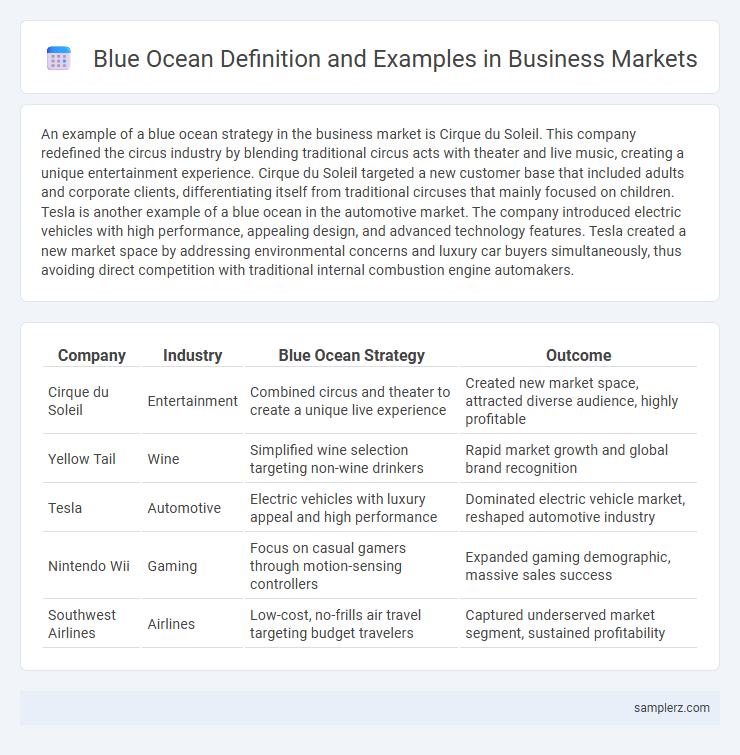An example of a blue ocean strategy in the business market is Cirque du Soleil. This company redefined the circus industry by blending traditional circus acts with theater and live music, creating a unique entertainment experience. Cirque du Soleil targeted a new customer base that included adults and corporate clients, differentiating itself from traditional circuses that mainly focused on children. Tesla is another example of a blue ocean in the automotive market. The company introduced electric vehicles with high performance, appealing design, and advanced technology features. Tesla created a new market space by addressing environmental concerns and luxury car buyers simultaneously, thus avoiding direct competition with traditional internal combustion engine automakers.
Table of Comparison
| Company | Industry | Blue Ocean Strategy | Outcome |
|---|---|---|---|
| Cirque du Soleil | Entertainment | Combined circus and theater to create a unique live experience | Created new market space, attracted diverse audience, highly profitable |
| Yellow Tail | Wine | Simplified wine selection targeting non-wine drinkers | Rapid market growth and global brand recognition |
| Tesla | Automotive | Electric vehicles with luxury appeal and high performance | Dominated electric vehicle market, reshaped automotive industry |
| Nintendo Wii | Gaming | Focus on casual gamers through motion-sensing controllers | Expanded gaming demographic, massive sales success |
| Southwest Airlines | Airlines | Low-cost, no-frills air travel targeting budget travelers | Captured underserved market segment, sustained profitability |
Defining Blue Ocean Strategy in Business
Blue Ocean Strategy in business involves creating uncontested market space by innovating beyond existing industry boundaries, thereby making competition irrelevant. A prime example is Cirque du Soleil, which blended elements of traditional circus and theater to attract a new customer base willing to pay a premium for a unique entertainment experience. This strategy emphasizes value innovation, simultaneously pursuing differentiation and low cost to open up new demand in unexplored markets.
Key Characteristics of Blue Ocean Markets
Blue Ocean markets are characterized by the creation of uncontested market space, where competition becomes irrelevant through innovation and value differentiation. Companies in these markets prioritize high value and low cost simultaneously, delivering unique products or services that meet untapped customer needs. Examples include Cirque du Soleil's reinvention of the circus experience and Airbnb's transformation of the hospitality industry, both driving growth by breaking traditional market boundaries.
Iconic Blue Ocean Example: Cirque du Soleil
Cirque du Soleil revolutionized the entertainment industry by creating a blue ocean market that combined traditional circus arts with theatrical storytelling, targeting adult audiences willing to pay premium prices. By eliminating costly elements like animal acts and emphasizing artistic performances, it crafted a unique value innovation that distinguished it from conventional circuses. This strategic differentiation allowed Cirque du Soleil to tap into an uncontested market space, achieving rapid growth and sustained profitability.
How Apple’s iTunes Created a Blue Ocean
Apple's iTunes revolutionized the digital music market by creating a blue ocean through offering a legal, easy-to-use platform for purchasing individual songs at affordable prices, eliminating the need to buy entire albums. This innovation bypassed traditional music distribution channels, reducing piracy and transforming consumer behavior. The seamless integration with iPods and a vast music library allowed Apple to dominate the digital music ecosystem, generating unprecedented revenue streams.
Nintendo Wii: Redefining the Gaming Experience
Nintendo Wii created a blue ocean by revolutionizing the gaming market with its innovative motion-sensing technology, targeting casual gamers and families rather than competing solely with high-performance consoles. This strategic shift expanded the gaming audience, driving unprecedented sales and establishing a new market space free from intense competition. The Wii's focus on accessibility and interactive gameplay demonstrated how product differentiation and customer-centric innovation can unlock untapped demand and profitable growth.
Tesla: Pioneering Electric Vehicle Market
Tesla revolutionized the automotive industry by creating a blue ocean market through its innovative electric vehicles, targeting environmentally conscious consumers and tech enthusiasts. The company leveraged cutting-edge battery technology and a distinct direct-to-consumer sales model, distinguishing itself from traditional automakers. By prioritizing sustainability and high-performance electric cars, Tesla established a new market space with minimal competition and high growth potential.
The Rise of Airbnb in Hospitality
Airbnb revolutionized the hospitality industry by creating a blue ocean market through peer-to-peer lodging, offering unique, affordable accommodations beyond traditional hotels. By leveraging technology and enabling homeowners to monetize extra space globally, Airbnb tapped into an underserved segment of travelers seeking personalized experiences. This innovative business model disrupted conventional hotel chains and expanded the hospitality market scope.
Starbucks: Brewing a New Coffeehouse Experience
Starbucks revolutionized the coffee industry by creating a blue ocean market through its unique customer experience, premium quality products, and upscale ambiance, differentiating itself from traditional coffee shops. The brand transformed coffee consumption into a lifestyle, emphasizing personalization and community, which allowed it to capture an untapped customer base willing to pay a premium. This strategic innovation expanded the market boundaries and established Starbucks as a global leader in the specialty coffee segment.
Southwest Airlines: Reinventing Air Travel
Southwest Airlines revolutionized the airline industry by creating a blue ocean market through low-cost, no-frills air travel, targeting price-sensitive customers underserved by traditional carriers. By eliminating expenses like assigned seating and offering point-to-point routes, Southwest reduced operational costs and increased efficiency. This strategic innovation allowed the airline to capture new demand, making air travel accessible to a broader customer base while maintaining profitability.
Tips for Identifying Blue Ocean Opportunities
Identify blue ocean opportunities by analyzing underserved customer segments and unmet needs within your industry to create innovative value propositions. Utilize tools like the Strategy Canvas and Buyer Utility Map to uncover gaps where competition is minimal and potential demand is high. Continuously monitor market trends and leverage cross-industry insights to develop unique offerings that differentiate your business from competitors.

example of blue ocean in market Infographic
 samplerz.com
samplerz.com